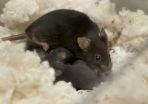(Press-News.org) (Philadelphia, PA) - It's long been known that scratching evokes a rewarding and pleasurable sensation in patients with chronic itch. Now, researchers in the Department of Dermatology and Temple Itch Center at Temple University School of Medicine (TUSM) may be closer to understanding why.
Using advanced fMRI imaging, the researchers looked at activity in the brain while 10 chronic itch patients and 10 healthy subjects scratched an itch. They found that areas of the brain involved in motor control and reward processing were more activated in chronic itch patients while they scratched. This overactivity may help explain the addictive scratching experienced by these patients. The study findings were published June 15 by the Journal of Investigative Dermatology.
"Chronic itch is a major symptom in dermatological diseases such as atopic eczema and psoriasis and a bothersome symptom in other diseases like end-stage renal disease," says Hideki Mochizuki, PhD, Assistant Professor of Dermatology at TUSM, and first author of the study initiated by Gil Yosipovitch, MD, Chair of Dermatology at TUSM, and Director of the Temple Itch Center.
"Despite being pleasurable at first, ongoing scratching can lead to an increase in the intensity of itch as well as pain and permanent skin damage," Dr. Mochizuki continues. "That is why it is important to understand the cerebral activity that may be inducing this pathological scratching behavior."
In a previous study by Dr. Yosipovitch's group, researchers investigated the cerebral mechanisms of scratching and its association with pleasure in healthy volunteers only.
According to Dr. Yosipovitch, this new study is the first to investigate brain activity during scratching in chronic itch patients.
During the study, itch was induced by applying cowhage (a plant) to the right forearms of patients with chronic itch and study participants without chronic itch. The patients were then imaged using fMRI while they scratched the itch. Researchers found that brain activity spiked in the chronic itch patients in the supplementary motor area, premotor cortex, and primary motor cortex - areas that are associated with motor control and motivation to act. In addition, brain areas involved in reward circuit such as the striatum, cingulate cortex, caudate nucleus and orbitofrontal cortex were significantly more activated than in healthy subjects.
"Our findings may enable us to identify and advance the understanding of the brain network underlying the itch-scratch cycle in chronic itch patients," says Mochizuki. "This understanding could lead to new therapies for these patients."
Chronic itch affects millions of Americans and is defined as itching that lasts for more than six weeks. It may be located over the entire body, or it may be limited to a single area. The chances of developing chronic itch increase with age.
INFORMATION:
Coauthors are Hideki Mochizuki, Leigh Nattkemper and Andrew Lin from Temple, and Alexandru D.P. Papoiu, Robert Kraft, and Robert Coghill from Wake Forest University.
This study was funded by a grant from the National Institute of Arthritis and Musculoskeletal and Skin Diseases (5ARO155904).
About Temple Health
Temple University Health System (TUHS) is a $1.8 billion academic health system dedicated to providing access to quality patient care and supporting excellence in medical education and research. The Health System consists of Temple University Hospital (TUH), ranked among the "Best Hospitals" in the region by U.S. News & World Report; TUH-Episcopal Campus; TUH-Northeastern Campus; Fox Chase Cancer Center, an NCI-designated comprehensive cancer center; Jeanes Hospital, a community-based hospital offering medical, surgical and emergency services; Temple Transport Team, a ground and air-ambulance company; and Temple Physicians, Inc., a network of community-based specialty and primary-care physician practices. TUHS is affiliated with Temple University School of Medicine.
Temple University School of Medicine (TUSM), established in 1901, is one of the nation's leading medical schools. Each year, the School of Medicine educates approximately 840 medical students and 140 graduate students. Based on its level of funding from the National Institutes of Health, Temple University School of Medicine is the second-highest ranked medical school in Philadelphia and the third-highest in the Commonwealth of Pennsylvania. According to U.S. News & World Report, TUSM is among the top 10 most applied-to medical schools in the nation.
Temple Health refers to the health, education and research activities carried out by the affiliates of Temple University Health System (TUHS) and by Temple University School of Medicine. TUHS neither provides nor controls the provision of health care. All health care is provided by its member organizations or independent health care providers affiliated with TUHS member organizations. Each TUHS member organization is owned and operated pursuant to its governing documents.
There is little information about bee populations in Alaska, where native bee pollination is critical to the maintenance of subarctic ecosystems. A team from the University of Alaska Fairbanks and the USDA have now completed a two-year study on bumble bees in agricultural areas in the region. The research was published in the Biodiversity Data Journal.
Pollination is one of the most fundamental processes sustaining agricultural production and natural ecosystems. While decrease in bee populations is a common concern, most press coverage has been directed towards Colony ...
Recent genomic research has prompted a petition that calls for the reclassification of African elephants from one threatened species to two endangered species to protect both from imminent extinction.
The U.S. Fish and Wildlife Service (FSW) has 90 days to respond to a petition from the Center for Biological Diversity at http://www.biologicaldiversity.org, a public interest environmental organization dedicated to the protection of native species and their habitats. The Center requests that the FWS recognize the forest elephant (Loxodonta cyclotis) and savannah elephant ...
A strain of bacteria that "breathes" uranium may hold the key to cleaning up polluted groundwater at sites where uranium ore was processed to make nuclear weapons.
A team of Rutgers University scientists and collaborators discovered the bacteria in soil at an old uranium ore mill in Rifle, Colorado, almost 200 miles west of Denver. The site is one of nine such mills in Colorado used during the heyday of nuclear weapons production.
The research is part of a U.S. Department of Energy program to see if microorganisms can lock up uranium that leached into the soil years ...
Zinc plays an important role in a woman's ability to successfully breast-feed her child, according to health researchers.
It has long been known that zinc, an essential trace element, is passed to infants through mother's breast milk. The levels of zinc in mother's milk and the effects of zinc deficiency in infants have been previously studied, but the role of zinc in breast development and function in lactating mothers is a relatively new area of research.
The protein ZnT2 transports zinc in specific tissues in the body, including the mammary glands. Shannon L. Kelleher ...
This news release is available in German. ETH material engineers found that the performance of ion-conducting ceramic membranes that are so important in industry depends largely on their strain and buckling profiles. For the first time, scientists can now selectively manipulate the buckling profile, and thus the physical properties, allowing new technical applications of these membranes.
"Ionics, ion-based data processing and energy conversion, is the electronics of the future", says Jennifer Rupp, a professor of Electrochemical Materials at ETH Zurich, and therewith ...
WASHINGTON, D.C. - The high seas of Mars may never have existed, according to a new study that looks at two opposite climate scenarios of early Mars and suggests that a cold and icy planet billions of years ago better explains water drainage and erosion features seen on the planet today.
For decades, researchers have debated the climate history of Mars and how the planet's early climate led to the many water-carved channels seen today. The idea that 3 to 4 billion years ago Mars was once warm, wet and Earth-like with a northern sea -- conditions that could have led ...
Researchers who paired Siamese fighting fish in mock fights found that winning fish could supply more energy to their muscles during fights than losing fish.
The findings link the invisible processes going on inside cells to tangible consequences in the visible world, and they show how a behavior such as aggression can be affected by underlying biochemical processes that help sustain an animal's life.
"Conspicuous adaptations like antlers are usually what come to mind when thinking about traits that maximize success in aggressive interactions, but as these interactions ...
Rich, creamy, nutritious and now cancer fighting. New research reveals that molecules derived from avocados could be effective in treating a form of cancer.
Professor Paul Spagnuolo from the University of Waterloo has discovered a lipid in avocados that combats acute myeloid leukemia (AML) by targeting the root of the disease - leukemia stem cells. Worldwide, there are few drug treatments available to patients that target leukemia stem cells.
AML is a devastating disease and proves fatal within five years for 90 per cent of seniors over age 65. Spagnuolo's new avocado-derived ...
The world's first study into the brain anatomy of a marine reptile that lived at the same time as the dinosaurs sheds light on how the reptilian brain adapted to life in the oceans.
The fossils of ichthyosaurs, which lived 150 to 200 million years ago, are often very well preserved, but they are commonly flattened. Now investigators have used computed tomography to create a 3-D scan of the animal's skull, revealing internal details of the palate and braincase that usually cannot be seen. A reconstruction of the brain shows the importance of vision for the predator, which ...
In a new study, older women who lived in places with higher air pollution had significantly reduced white matter in the brain. For the study, a research team took brain MRIs of 1403 women who were 71 to 89 years old and used residential histories and air monitoring data to estimate their exposure to air pollution in the previous 6 to 7 years.
The findings suggest that ambient particulate air pollutants may have a deleterious effect on brain aging.
"Investigating the impact of air pollution on the human brain is a new area of environmental neurosciences. Our study provides ...




